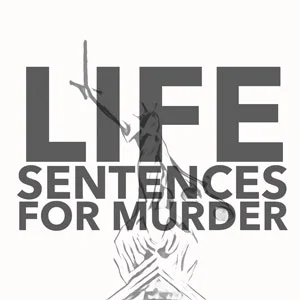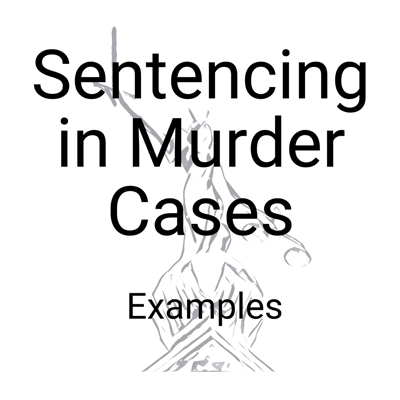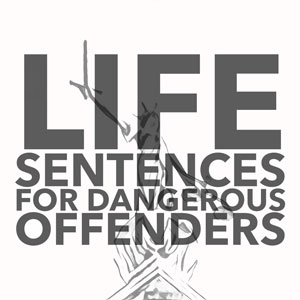Imposing Life Sentences for Murder and Other Serious Offences
All Contents > Sentencing Home > How Sentencing Works > My Sentencing Hearing > Sentencing Guidelines > Life Sentences > Extended Sentences
“For an offence of murder, a life sentence is mandatory, although as you can see on this page, life rarely means life. Only where a Whole Life Order is imposed will an offender be ineligible for release on parole.
In other cases, where the individual offence carries a maximum of life, a sentence of imprisonment for life is discretionary. ”
LIFE SENTENCES
Life sentences are reserved for the most serious offences and offenders.
For an offence of murder, a life sentence is mandatory, although as you can see on this page, life rarely means life. Only where a Whole Life Order is imposed will an offender be ineligible for release on parole.
In other cases, where the individual offence carries a maximum of life, a sentence of imprisonment for life is discretionary.
There are two further situations in which a judge is likely to consider imposing life imprisonment for serious offences: first, where the defendant is assessed as a dangerous offender and secondly where the defendant already has a previous conviction for a serious offence.
LIFE SENTENCES FOR MURDER
For murder, life imprisonment is the only sentence that can be imposed for defendants aged 21 or over. Defendants convicted of murder aged 18-20 are sentenced to custody for life and juveniles (under 18s) are sentenced to detention at His Majesty’s pleasure.
Sentencing in Murder Cases
Life rarely means life. When passing a life sentence a judge usually imposes a minimum custodial term (a minimum term order) that must be served before an application can be made for release on parole; once released a defendant will be on licence for the remainder of his/her natural life and may be recalled to prison if considered a risk to the public (this may involve committing a further offence but does not need to).
In the most serious cases of murder, a Whole Life Order can be imposed for defendants aged 21 or over, in which case life does mean life. When this happens there will be no minimum term imposed and the prisoner will not be eligible for release at any time. A prisoner in this situation can only be released by the Home Secretary on compassionate grounds (e.g. due to very poor health).
When a minimum term order is imposed, there is no sentencing guideine for deciding on the appropriate minimum term. Instead, the Sentencing Code (Sentencing Act 2020, sections 321, 322 and Schedule 21) sets out the approach the courts should take.
[For defendants sentenced before 1 December 2020, the minimum term will have been decided under the equivalent provisions contained in the Criminal Justice Act 2003 sections 269 to 277 and Schedule 21.]
The approach adopted by judges when sentencing in murder cases is contained in the Crown Court Compendium Part II: Sentencing (section S5.14).
The 3-step approach to sentencing in murder cases
Schedule 21 sets out the general principles that judges follow in cases of murder.
Step 1 - Determine the starting point.
Step 2 - Adjust the starting point in line with any additional Aggravating or Mitigating Factors
Step 3 - Adjust the sentence in line with any previous convictions, offences committed on bail, guilty pleas and any time spent on remand.
STEP 1 – Determine the Starting Point
There are 5 starting points set out below:
Whole Life Order - The ‘exceptionally high' seriousness category
30 years - The 'particularly high' seriousness category
25 years - The 'weapons' category
15 years - The 'usual' starting point for 18+ yrs defendants
12 years - The starting point for juveniles (under 18s)
Whole Life Order (where life means life)
The ‘exceptionally high' seriousness category
Sentencing Act 2020, Schedule 21, section 2
The starting point is a Whole Life Order where the seriousness of the offence (or of the offence and other associated offences) is ‘exceptionally high’ and the defendant was aged 21 or over when the offence was committed.
Cases that would normally fall into this category include:
(a) the murder of two or more people where each murder involves (i) a substantial degree of premeditation/planning, (ii) abduction of the victim, or (iii) sexual or sadistic conduct;
(b) the murder of a child if involving the abduction of the child or sexual or sadistic motivation;
(c) the murder of a police officer or prison officer in the course of his or her duty, where the offence was committed on or after 13 April 2015,
(d) murder committed to advance a political/religious/racial/ideological cause;
(e) murder committed by a defendant with a previous conviction for murder.
30 years starting point
The 'particularly high' seriousness category
Sentencing Act 2020, Schedule 21, section 3
For cases that do not fall within the whole life category (because the seriousness of the offence/associated offences is not exceptionally high or the defendant was not aged 21 or over when the offence was committed) but the seriousness of the offence and any associated offences was ‘particularly high’ and the defendant was aged 18 or over when the offence was committed, the starting point for the minimum custodial term in a murder case is 30 years.
If they did not fall into the ‘exceptionally high’ category, cases within the ‘particularly high’ category would normally include:
(a) in the case of an offence committed before 13 April 2015, the murder of a police officer or prison officer in the course of his or her duty,
(b) a murder involving the use of a firearm or explosive,
(c) a murder done for gain (such as a murder done in the course or furtherance of robbery or burglary, done for payment or done in the expectation of gain as a result of the death),
(d) a murder intended to obstruct or interfere with the course of justice,
(e) a murder involving sexual or sadistic conduct,
(f) the murder of two or more persons,
(g) a murder that is aggravated by racial or religious hostility or by hostility related to sexual orientation,
(h) a murder that is aggravated by hostility related to disability or transgender identity, where the offence was committed on or after 3 December 2012 (or over a period, or at some time during a period, ending on or after that date),
(i) a murder falling within the ‘exceptionally high’ (whole life order) category committed by an offender who was aged under 21 when the offence was committed.
25 years starting point
The 'weapons' category
Sentencing Act 2020, Schedule 21, section 4
For cases that do not fall within the ‘exceptionally high’ or ‘particularly high’ categories, the offence will normally to be regarded as sufficiently serious for the appropriate starting point for the minimum term to be 25 years where:
the defendant was 18 or older when the offence was committed; and
the offence was committed on or after 2 March 2010; and
the defendant took a knife or other weapon to the scene intending to (a) commit any offence, or (b) have it available to use as a weapon, and used that knife or other weapon in committing the murder.
15 years starting point
The 'usual' starting point for 18+ yrs defendants
Sentencing Act 2020, Schedule 21, section 5
For cases that do not fall within the ‘exceptionally high’ or ‘particularly high’ categories, and for cases that do not fall within the ‘weapons’ category, the minimum term starting point for defendants who were aged 18 or over when the offence was committed will be 15 years.
12 years starting point
The starting point for juveniles (under 18s)
Sentencing Act 2020, Schedule 21, section 6
Defendants who were under 18 when the murder offence was committed will have a minimum term starting point of 12 years.
This is the starting point for under 18s even in particularly serious cases, although starting points will be adjusted in line with aggravating and mitigating circumstances.
STEP 2 – Adjust the starting point in line with any additional Aggravating or Mitigating Factors
Aggravating and Mitigating Factors
Having established the correct starting point, the sentencing judge in a murder case must then go on to consider the aggravating and mitigating factors set out in the Sentencing Act 2020, Schedule 21, sections 7-11.
A judge has to be careful not to ‘double count’ by, for example, taking into account as an aggravating factor a matter which has already been taken into account in Step 1 to determine the starting point.
Consideration of aggravating factors could move a case into a whole life order category from a lower category (for offenders who were 21 or over when the offence was committed) and consideration of mitigating factors could bring the sentence down to a relatively low minimum term (well below the starting points). The final sentence depends on the precise circumstances of the case and every case is different.
Aggravating Factors
Sentencing Act 2020, Schedule 21, section 9
Aggravating factors include:
a) a significant degree of planning or premeditation,
(b) the fact that the victim was particularly vulnerable because of age or disability,
(c) mental or physical suffering inflicted on the victim before death,
(d) the abuse of a position of trust,
(e) the use of duress or threats against another person to facilitate the commission of the offence,
(f) the fact that victim was providing a public service or performing a public duty, and
(g) concealment, destruction or dismemberment of the body.
Mitigating Factors
Sentencing Act 2020, Schedule 21, section 10
(a) an intention to cause serious bodily harm rather than to kill,
(b) lack of premeditation,
(c) the fact that the offender suffered from any mental disorder or mental disability which (although not falling within section 2(1) of the Homicide Act 1957) lowered the offender’s degree of culpability,
(d) the fact that the offender was provoked (for example, by prolonged stress) but, in the case of a murder committed before 4 October 2010, in a way not amounting to a defence of provocation,
(e) the fact that the offender acted to any extent in self-defence or, in the case of a murder committed on or after 4 October 2010, in fear of violence,
(f) a belief by the offender that the murder was an act of mercy, and
(g) the age of the offender.
Step 3 – Previous Convictions, Offences committed on Bail, Guilty Pleas and Time Spent on Remand
Sentencing Act 2020, Schedule 21, section 11
The third step in the process is to consider:
(1) the defendant’s previous convictions (if any);
(2) whether the offence was committed when the defendant was already on bail for another offence;
(3) whether the defendant pleaded guilty and, if so, at what stage in the proceedings; and
(4) time spent on remand in custody or on bail with a curfew condition prior to sentence.
Previous Convictions
Previous convictions can be treated as an aggravating factor in a sentence taking into account the nature of the previous offence and its relevance to the current offence, as well as how recent the previous offence was (s.65 Sentencing Act 2020.) For example, previous convictions for carrying a knife and using violence are likely to be treated as an aggravating feature in a street stabbing murder case. On the other hand, previous convictions for benefit fraud in the same case are likely to have no relevance at all and therefore to be disregarded.
Defendant on Bail when Offence Committed
If the defendant was on bail when the offence of murder was committed, this will be taken into account as an aggravating factor (s.64 Sentencing Act 2020).
Guilty Plea in Murder Cases
Where the case clearly merits a whole life order, a guilty plea will not change this, albeit a guilty plea is one of many factors the court will take into account in determining whether a whole life order should be imposed.
In cases where a whole life order is not imposed, the Reduction in Sentence for a Guilty Plea Sentencing Guideline provides that if a defendant has pleaded guilty, this should be taken into account in determining the starting point. For an early guilty plea, this can reduce the starting point by up to 5 years or ⅙, whichever is less. A late plea of guilty on the day of trial is likely to receive a maximum discount of one-twentieth (5%).
Time Spent on Remand
Where defendants have spent time in custody prior to trial or sentence, or been on bail with a qualifying curfew condition, this should be taken into account by the judge as an appropriate reduction when setting the minimum term.
Arriving at the minimum term to be served
Having moved through Steps 1 to 3, the judge will now have arrived at the minimum term to be imposed.
In setting the minimum term the judge should clearly explain how the minimum term has been reached during his/her sentencing remarks. After serving this minimum term the defendant will be able to apply for release on parole.
Below are a number of real case examples which demonstrate how judges approach this sentencing exercise in practice.
Recent Cases - Sentencing for Murder
Below are links to the sentencing remarks in murder cases which demonstrate how judges approach this sentencing task in practice.
** PLEASE NOTE - the cases referred to below contain graphic descriptions of violence and murder. Discretion is advised. **
All links open on a new page.
R -v- Jake Hill, Tia Taylor and Chelsea Powell, Truro Crown Court, 12 April 2024
R -v- Michael Davis & Kayleigh Driver, Leicester Crown Court, 10 April 2024
R -v- Remi Gordon and Kami Carpenter, Birmingham Crown Court, 8 April 2024
R -v- Ian Gary Connell, Manchester Crown Court, 6 March 2024
R -v- Shaun Pendlebury, Ashana Studholme, Lisa Richardson, Central Criminal Court, 1 March 2024
R -v- Joshua Jacques, Central Criminal Court, 1 March 2024
R -v- Marcus Osborne, Leeds Crown Court, 1 March 2024 (Whole Life Order)
R v- Scarlet Blake, Oxford Crown Court, 26 February 2024
R -v- Sandip Patel, Central Criminal Court, 16 February 2024
R -v- Scarlett Jenkinson and Eddie Ratcliffe, Manchester Crown Court, 2 February 2024. See also Jenkinson & Ratcliffe sentencing remarks.
R -v- Felipe Figueiredo, Preston Crown Court, 26 January 2024
R -v- Valdo Calocane, Nottingham Crown Court, 25 January 2024 (Manslaughter (diminished responsibility) / Attempted Murder / Hospital Order), See also Valdo Cocaine sentencing remarks.
R -v- Jack Benham and Sian Hedges, Maidstone Crown Court, 12 January 2024. See also Benham & Hedges sentencing remarks.
R -v- Michael Daymond and Dana Carr, Teeside Crown Court, 21 December 2023
R -v- Lawrence Bierton, Nottingham Crown Court, 20 December 2023 (Whole Life Order)
R -v- Darren Osment, Bristol Crown Court, 20 December 2023
R -v- Cameron Baker, Winchester Crown Court, 12 December 2023
R -v- Christopher El Gifari, Cardiff Crown Court, 1 December 2023
R -v- AB and CD, Northampton Crown Court, 30 November 2023
R -v- Joseph Peers, Sean Zeisz, Niall Barry and James Witham, Liverpool Crown Court, 22 November 2023. See also Peers & Others broadcast sentencing remarks.
R -v- Lucy Letby, Manchester Crown Court, 21 August 2023 (Whole Life Order). See also Letby broadcast sentencing remarks.
R -v- Louis de Zoysa, Norhampton Crown Court, 27 July 2023 (Whole Life Order). See also de Soysa broadcast sentencing remarks.
R -v- Justin Plummer, Aylesbury Crown Court, 25 July 2023
R -v- Veadhesa & Shergill, Wolverhampton Crown Court, 13 July 2023. See also Veadhesa & Shergill broadcast sentencing remarks.
R -v- Barrow, Nottingham Crown Court, 7 July 2023
R -v- Chapman and Waring, Liverpool Crown Court, 7 July 2023. See also Chapman & Waring broadcast sentencing remarks.
R -v- Erik Feld, Central Criminal Court, 14 June 2023
R -v- David Smith, Inner London Crown Court, 26 May 2023
R -v- Boyd, Newcastle Crown Court, 23 May 2023
R -v- Balakrishnan & Suleiman, Central Criminal Court, 10 May 2023
R -v- Marques Walker, Central Criminal Court, 9 May 2023
R -v- Bevan and James, Swansea Crown Court, 25 April 2023
R -v- Palaj and others, Bristol Crown Court, 21 April 2023
R v Cashman, Manchester Crown Court, 3 April 2023. See also Cashman broadcast sentencing remarks. See also Cashman appeal attempt (dismissed).
R v Ray, Newcastle Crown Court, 23 March 2023
R v Rule, Lincoln Crown Court, 17 March 2023
R v Groves, Winchester Crown Court, 22 February 2023
R v M & Others, Birmingham Crown Court, 15 February 2023
R v David Carrick, Southwark Crown Court, 7 February 2023
R v Al-Jundi and El-Abboud, Central Criminal Court, 1 February 2023
R v Whelan & Keating, Newcastle Crown Court, 25 January 2023
R v McGrory, Huntingdon Crown Court, 13 January 2023
R v Boboc & Chers, Bristol Crown Court, 21 December 2022
R v McSweeney, Central Criminal Court, 14 December 2022
R v Craig, Bristol Crown Court, 10 November 2022. See also Steven Craig broadcast sentencing remarks.
R v Latoszewski & Kalinowska, Leeds Crown Court, 3 November 2022. See also Latoszewski & Kalinowska broadcast sentencing remarks.
R v Culea, Derby Crown Court, 28 October 2022
R v Mitchell, Central Criminal Court, 28 October 2022. See also Jemma Mitchell broadcast sentencing remarks.
R -v- Kigundu, Reading Crown Court, 7 October 2022 (Whole Life Order)
R v Kelly, Warwick Crown Court, 26 July 2022
R v Venables, Worcester Crown Court, 20 July 2022
R v Pickford and others, Stafford Crown Court, 15 July 2022
In the matter of the murder of Ava White, Liverpool Crown Court, 11 July 2022
R v Wheeler, Canterbury Crown Court, 8 July 2022
R v Watson, Central Criminal Court, 24 June 2022
R v Cashin & others, Manchester Crown Court, 21 June 2022
R v Arslan, Bristol Crown Court, 21 June 2022
R v Hawley and others, Maidstone Crown Court, 23 May 2022
R v Zain, Manchester Crown Court, 18 May 2022
R v Ali, Central Criminal Court, 13 April 2022 (Whole Life Order)
R v Jeremy and others, Newport Crown Court, 13 April 2022
R v Selamaj, Central Criminal Court, 8 April 2022
R v Stewart, Huntingdon Crown Court, 9 February 2022 (Whole Life Order) (Sentence reduced to a minimum term of 35 years following appeal on 29 July 2022)
R v Demmon, Gloucester Crown Court 4 February 2022
R v Boulton, Lincoln Crown Court, 2 February 2022
R v Scott, Manchester Crown Court, 20 January 2022
R v Wright & Hennessy, Cambridge Crown Court, 22 December 2021
R v Brockhill & Smith, Bradford Crown Court, 15 December 2021
R v Fuller, Maidstone Crown Court, 15 December 2021 (Whole Life Order). See also further sentencing in the Central Criminal Court on 7 December 2022
R v Guest-More, Chester Crown Court, 10 December 2021
R v Tustin & Hughes, Coventry Crown Court, 3 December 2021 (Hughes’ sentence for manslaughter increased from 21 to 24 years’ imprisonment following appeal on 29 July 2022)
R v Darnton, Preston Crown Court, 12 November 2021
R v Askew, Newcastle Crown Court, 10 November 2021
R v Couzens, Central Criminal Court, 30 September 2021 (Whole Life Order) (Sentence upheld on appeal on 29 July 2022)
R v Karolia and others, Leeds Crown Court, 30 July 2021
LIFE SENTENCES FOR DANGEROUS OFFENDERS
A life sentence must be imposed where:
(1) a defendant aged 18 or over has been convicted of a Schedule 19 Offence (see below for the meaning of a ‘Schedule 19 offence’); and
(2) the court considers that there is a significant risk to members of the public of serious harm occasioned by the commission by the defendant of further specified offences (see below for the meaning of ‘serious harm’ and ‘specified offence’); and
(3) the court considers that the seriousness of the offence (alone or in combination with associated offences) is such as to justify imprisonment for life.
The power to impose a life sentence in these circumstances is contained in section 285 Sentencing Act 2020 (for defendants aged 21 and over when convicted) and section 274 Sentencing Act 2020 (for defendants who aged 18-20 when convicted).
As would be expected, life sentences are intended for dangerous offenders who have committed offences of the utmost gravity.
When a life sentence is imposed in such circumstances, the judge will set a minimum term that the defendant must serve in custody before being eligible for release.
Once the minimum term expires the defendant can apply for parole and will be released if deemed by the parole board not to pose a risk to the public. Once released, the defendant remains on licence for life.
This means (s)he is liable to be recalled in the event of failing to abide by any conditions of release or if considered to be a risk to the public during this period.
What is a Schedule 19 offence?
Section 307 Sentencing Act 2020 defines Schedule 19 offences as specified offences (see below) which carry a maximum term of life - they are all listed in Schedule 19 of the Sentencing Act 2020 and include manslaughter, kidnapping, grievous bodily harm with intent, robbery, rape, human trafficking and a number of terrorism offences.
What is Serious Harm?
‘Serious harm’ means death or serious personal injury, whether physical or psychological (s.306(2) Sentencing Act 2020).
What is a Specified Offence?
There are 3 types of specified offences (s.306 Sentencing Act 2020):
(a) specified violent offences (specified in Part 1 of Schedule 18 of the Sentencing Act 2020), such as manslaughter, actual bodily harm (ABH), grievous bodily harm (GBH), child cruelty, robbery, arson, affray and violent disorder; or
(b) a specified sexual offence (specified in Part 2 of Schedule 18), such as rape, sexual assault, paying for sexual services of a child, administering a substance with intent, trafficking for sexual exploitation, exposure and voyeurism; or
(c) a specified terrorism offence (specified in Part 3 of Schedule 18), such as membership of a proscribed organisation, possessing an article for terrorist purposes, encouragement of terrorism, preparation of terrorist acts and training for terrorism.
How do judges assess the risk of serious harm?
In reaching a decision about whether a defendant poses a significant risk to members of the public of serious harm occasioned by the commission by him/her of further specified offences (i.e. whether the defendant is a dangerous offender), the court takes into account those matters set out in s.308 Sentencing Act 2020:
(a) the court must take into account all the information that is available to it about the nature and circumstances of the offence,
(b) the court may take into account all the information that is available to it about the nature and circumstances of any other offences of which the offender has been convicted by a court anywhere in the world,
(c) the court may take into account any information which is before it about any pattern of behaviour of which any of the offences mentioned in paragraph (a) or (b) forms part, and
(d) the court may take into account any information about the offender which is before it.
LIFE SENTENCES FOR DEFENDANTS WITH A PREVIOUS CONVICTION FOR A LISTED OFFENCE
A life sentence must be imposed where:
A defendant aged 18 or over is convicted of an offence in Part 1 of Schedule 15 of the Sentencing Act 2020 (Part 1 includes offences of manslaughter, wounding with intent, possessing a firearm with intent, armed robbery, terrorism offences, human trafficking, rape and other serious sexual offences); and
The court considers that the offence would merit a custodial sentence of at least 10 years; and
When the offence was committed, the defendant had a previous conviction for an offence listed in any part of Schedule 15 (Schedule 15 includes the offences in Part 1 above and those in the rest of the schedule, including murder and armed forces offences); and
For that previous conviction, the defendant received a sentence of at least 10 years, an extended sentence with a custodial term of at least 10 years, or a life sentence with a minimum term of 5 years;
UNLESS the judge considers that there are particular circumstances which relate to the offence, the previous offence or to the defendant which would make it unjust to pass a life sentence in all the circumstances.
The power to impose a life sentence in these circumstances is contained in section 283 Sentencing Act 2020 (for defendants aged 21 and over when convicted) and section 273 Sentencing Act 2020 (for defendants who are aged 18-20 when convicted).
In passing a life sentence, the judge will impose a minimum term in the same way as described above.



























